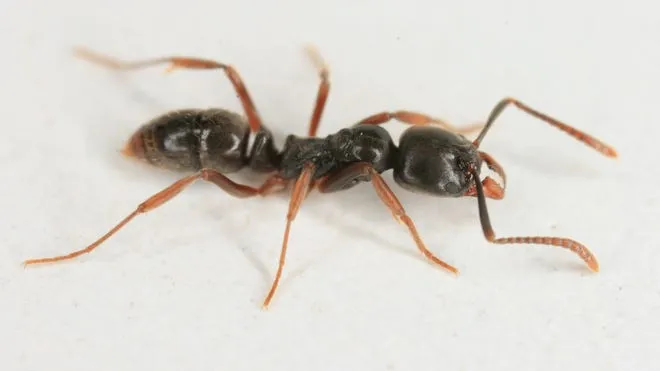The Asian Needle Ant: A Tiny Invader with a Big Impact
As the climate warms and ecosystems shift, invasive species are becoming a household concern in regions previously untouched by their presence. One such species gaining notoriety is the Asian needle ant (Pachycondyla chinensis), a small yet aggressive ant known for its potent sting and invasive tendencies. As reports from Texas indicate its firm establishment, it raises questions about our preparedness to combat the spread of invasive species.
Origin and Characteristics of the Asian Needle Ant
The Asian needle ant is believed to be native to East Asia, particularly China, Korea, and Japan. It has gained a foothold in the United States after being first identified in the U.S. in the mid-2000s, with Texas currently being a primary site of infestation. The ant is typically dark brown or black and can reach up to 6.35 mm in length. One of its alarming traits is its powerful sting, which can cause significant pain and discomfort, similar to a wasp sting.
Why the Asian Needle Ant is a Cause for Alarm
The rise of Asian needle ants in U.S. ecosystems poses multiple threats. Firstly, their aggressive nature allows them to displace native ant species, leading to imbalances in local ecosystems. As numerous species of ants have crucial roles in soil aeration, seed dispersal, and the breakdown of organic material, the loss of native populations can have cascading effects on biodiversity.
Additionally, the sting of the Asian needle ant can become a significant health concern. Individuals allergic to the venom may experience life-threatening reactions, understating the need for awareness, especially in areas where these ants have become established.
Expansion Trends: Mapping the Spread
A recent focus on the geographic spread of the Asian needle ant reveals alarming trends. After the initial discovery in Texas, sightings have been reported in several southern states including Louisiana and Alabama. Experts believe that the ant is likely to continue expanding its territory as it thrives in warmer climates.
As temperatures soar, the Asian needle ant has shown a remarkable ability to adapt and colonize new areas. In urban and suburban settings, they often find plentiful food sources ranging from sugary foods to fatty substances, which further support their proliferation.
Impact on Local Ecosystems
The introduction of the Asian needle ant threatens not only native ant species but also the broader ecosystem. Ants typically play significant roles in controlling pest populations, degrading organic matter, and even acting as food sources for other wildlife. When an invasive species outcompetes native ants, it can cause a cascade of ecological imbalance, influencing plant growth, seed dispersal, and nutrient cycling.
Research indicates that when the Asian needle ant colonizes an area, it can dominate, leading to the decline of other ant species by predation and competition. This relentless competition disrupts the natural interactions among species, affecting flowers, plants, and even soil microorganisms.
Vigilance: The Key to Control
Understanding how to identify and manage Asian needle ants is crucial. Since they can easily go unnoticed due to their size, raising public awareness becomes a challenging yet critical task. Educational campaigns should focus on proper identification, emphasizing the signature features such as their size, coloration, and behavior.
For those who suspect an infestation, experts recommend taking photographs of the ants and their nests and reporting findings to local pest control authorities or university entomology departments. Prompt reporting can help ecologists track the spread and develop intervention strategies to manage populations effectively.
Public Health Concerns
While the ecological impacts are potent, we mustn’t overlook the public health concerns associated with the Asian needle ant. Their sting, described as more intense than that of many native ant species, has led to considerable discomfort for individuals who have encountered them. Symptoms can include sharp pain, swelling, and, in severe cases, allergic reactions warranting medical attention. These health risks also become problematic in outdoor recreational areas where families gather for picnics or camping, heightening the urgency for increased awareness.
The Role of Research and Entomologists
Scientists and entomologists are crucial in studying the behavior and tendencies of invasive species like the Asian needle ant. Detailed research can help create effective management plans and develop biological control measures. The ongoing monitoring of their spread and the ecological impact will inform future solutions and policies targeting invasive species.
Efforts to involve local communities in monitoring and reporting can amplify these endeavors, allowing researchers to gather more data and respond quickly to new infestations.
Your Role in Combating Invasive Species
As stewards of the environment, individuals can take simple yet effective steps to mitigate the spread of invasive species, such as:
- Cleaning outdoor gear: Before moving between different ecosystems, ensure that your clothing, shoes, equipment, and pets are free from ants and other potential invaders.
- Avoiding the release of pets: Never release exotic pets or plants into the wild, as they can quickly become invasive.
- Reporting sightings: If you suspect you’ve seen an Asian needle ant or any other invasive species, document it and report it to the appropriate authorities.
The Path Forward: Remaining Vigilant and Prepared
Ultimately, the rapid spread of the Asian needle ant serves as a stark reminder of the ever-looming threat of invasive species. As homeowners, outdoor enthusiasts, and policy-makers, we must remain vigilant and proactive in our approach to dealing with these pests. Increased public awareness can play a critical role in slowing the advance of these tiny, yet formidable, invaders.
Through collaboration and constant vigilance, we can protect our ecosystems and contribute to the sustainability of our shared environment while ensuring that our outdoor experiences remain safe and enjoyable for all.
Conclusion
The invasion of the Asian needle ant is a pressing issue that highlights the interconnectedness of ecosystems in the face of climate change and human activities. Understanding this invasive species encourages us to be more cautious and informed when enjoying the outdoors. By taking collective action and remaining alert, we can help safeguard against the rising wave of invasive threats and preserve the balance of our native ecosystems.







